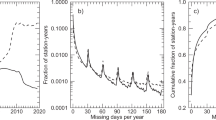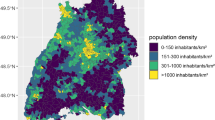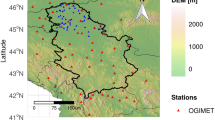Abstract
Mitigation of adverse effects of air pollution requires understanding underlying exposures, such as ambient ozone concentrations. Geostatistical approaches were employed to analyze temporal trends and estimate spatial patterns of summertime ozone concentrations for Houston, Texas, based on hourly ozone observations obtained from the Texas Commission on Environmental Quality. We systematically assess the accuracy of several spatial interpolation methods, comparing inverse distance weighting, simple kriging, ordinary kriging, and universal kriging methods utilizing the hourly ozone observations and meteorological measurements from monitoring sites. Model uncertainty was assessed by leave-one-out cross-validation. Kriging methods performed better, showing greater consistency in the generated surfaces, fewer interpolation errors, and lower biases. Universal kriging did not significantly improve the interpolation results compared to ordinary kriging, and thus ordinary kriging was determined to be the optimal method, striking a balance between accuracy and simplicity. The resulting spatial patterns indicate that the more industrialized areas east and northeast of Houston exhibit the highest summertime ozone concentrations. Estimated daily maximum 8 h ozone concentration fields generated will be used to inform research on population health risks from exposure to surface ozone in Houston.
This is a preview of subscription content, access via your institution
Access options
Subscribe to this journal
Receive 6 print issues and online access
$259.00 per year
only $43.17 per issue
Buy this article
- Purchase on Springer Link
- Instant access to full article PDF
Prices may be subject to local taxes which are calculated during checkout








Similar content being viewed by others
References
Knowlton K, Rosenthal JE, Hogrefe C, B. L, Gaffin S, Goldberg R, et al. Assessing ozone-related health impacts under a changing climate. Environ Health Perspect. 2004;112:1557–63.
Logan JA. Tropospheric ozone: seasonal behavior, trends, and anthropogenic influence. J Geophys Res. 1985;90(D6):10463–82.
Intergovernmental Panel on Climate Change (IPCC). Managing the risks of extreme events and disasters to advance climate change adaptation. Cambridge: Cambridge University Press; 2012. p. 582.
Stafoggia M, Forastiere F, Faustini A, Biggeri A, Bisanti L, Cadum E, et al. Susceptibility factors to ozone-related mortality: a population-based case-crossover analysis. Am J Respir Crit Care Med. 2010;182:376–84.
Adam-Poupart A, Brand A, Fournier M, Jerrett M, Smargiassi A. Spatiotemporal modeling of ozone levels in Quebec (Canada): a comparison of kriging, land-use regression (LUR), and combined bayesian maximum entropy-LUR approaches. Environ Health Perspect. 2014;122:970–6.
Bell ML, Dominici F, Samet JM. A meta-analysis of time-series studies of ozone and mortality with comparison to the National Morbidity, Mortality, and Air Pollution Study. Epidemiology. 2005;16:436–45.
Ruidavets J-B. Ozone air pollution is associated with acute myocardial infarction. Circulation. 2005;111:563–9.
Genc S, Zadeoglulari Z, Fuss SH, Genc K. The adverse effects of air pollution on the nervous system. J Toxicol. 2012;2012:1–23.
Conlon Kathryn, Monaghan Andrew, Hayden Mary, Wilhelmi O. Correction: Potential impacts of future warming and land use changes on intra-urban heat exposure in Houston, Texas. PLoS ONE. 2016;11:e0151226–4..
Liu LJS, Rossini AJ. Use of kriging models to predict 12-hour mean ozone concentrations in metropolitan Toronto - a pilot study. Environ Int. 1996;22:677–92.
Knotters M, Brus DJ, Oude Voshaar JH. A comparison of kriging, co-kriging and kriging combined with regression for spatial interpolation of horizon depth with censored observations. Geoderma. 1995;67:227–46.
Lefohn AS, Simpson J, Knudsen HP, Bhumralkar C, Logan JA. An evaluation of the kriging method to predict 7-h seasonal mean ozone concentrations for estimating crop losses. J Air Pollut Control Assoc. 1987;37:595–602.
Chestnut LG, Schwartz J, Savitz DA, Bruchfiel CM. Pulmonary function and ambient particulate matter: epidemiological evidence from NHANES I. Arch Environ Heal. 1991;46:135–44.
Kinney PL, Aggarwal M, Nikiforov SV, Nadas A. Methods development for epidemiologic investigations of the health effects of prolonged ozone exposure. Part III. An approach to retrospective estimation of lifetime ozone exposure using a questionnaire and ambient monitoring data (U.S. sites). Res Rep Health Eff Inst. 1998;81:79–121.
Tashkin DP, Clark VA, Simmons M, Reems C, Coulson AH, Bourque LB, et al. The UCLA population studies of chronic obstructive respiratory disease. VII. Relationship between parental smoking and children’s lung function. Am Rev Respir Dis. 1984;129:891.
Schwartz J, Zeger S. Passive smoking, air pollution, and acute respiratory symptoms in a diary study of student nurses. Am Rev Respir Dis. 1990;141:62–7.
Stern BR, Raizenne ME, Burnett RT, Jones L, Kearney J, Franklin CA. Air pollution and childhood respiratory health: Exposure to sulfate and ozone in 10 Canadian rural communities. Environ Res. 1994;66:125–42.
Künzli N, Lurmann F, Segal M, Ngo L, Balmes J, Tager IB. Association between lifetime ambient ozone exposure and pulmonary function in college freshmen - results of a pilot study. Environ Res. 1997;72:8–23.
Vedal S, Petkau J, White R, Blair J. Acute effects of ambient inhalable particles in asthmatic and nonasthmatic children. Am J Respir Crit Care Med. 1998;157(4 PART I):1034–43.
Lefohn AS, Knudsen HP, McEvoy LR. The use of kriging to estimate monthly ozone exposure parameters for the Southeastern United States. Environ Pollut. 1988;53:27–42.
Stahl K, Moore RD, Floyer JA, Asplin MG, McKendry IG. Comparison of approaches for spatial interpolation of daily air temperature in a large region with complex topography and highly variable station density. Agric Meteorol. 2006;139:224–36.
Schloeder CA, Zimmerman NE, Jacobs MJ. Comparison of methods for interpolating soil properties using limited data. Soil Sci Soc Am J. 2001;65:470.
Zimmerman D, Pavlik C, Ruggles A, Armstrong MP. An experimental comparison of ordinary and universal kriging and inverse distance weighting. Math Geol. 1999;31:375–90.
Li J, Heap AD. A review of comparative studies of spatial interpolation methods in environmental sciences: performance and impact factors. Ecol Inf. 2011;6:228–41.
Li J, Heap A. A review of spatial interpolation methods for environmental scientists. Geoscience Australia, Record 2008/23, 137.
Sailor D. Determinants of indoor and outdoor exposure to ozone and extreme heat in a warming climate and the health risks for an aging population. In: Science to Achieve Results (STAR) Indoor Air & Climate Change Progress Review Meeting and Webinar. Science to Achieve Results (STAR) Indoor Air & Climate Change Progress Review Meeting and Webinar, Office of Research and Development (ORD) (United States Environmental Protection Agency, Washington, DC 2016).
Emerson MO, Bratter J, Howell J, Jeanty PW, Cline, M. Houston region grows more racially/ethnically diverse, with small declines in segregation. A Joint Report Analyzing Census Data From 1990, 2000 and 2010. Kinder Institute for Urban Research & The Hobby Center for the Study of Texas; 2012.
Bethel HL, Sexton K, Linder S, Delclos G, Stock T, Abramson S, et al. A closer look at air pollution in Houston: identifying priority health risks. Houston: Mayor’s Task Force on the Health Effects of Air Pollution; 2006.
Couzo E, Jeffries HE, Vizuete W. Houston′s rapid ozone increases: preconditions and geographic origins. Environ Chem. 2013;10: 260–68.
Li G, Zhang R, Fan J, Tie X. Impacts of biogenic emissions on photochemical ozone production in Houston, Texas. J Geophys Res Atmos. 2007;112:D10309.
Wiedinmyer C, Guenther A, Estes M, Strange IW, Yarwood G, Allen DT. A land use database and examples of biogenic isoprene emission estimates for the state of Texas, USA. Atmos Environ. 2001;35:6465–77.
Cowling E, Furiness C, Dimitriades B, Parrish D. Final rapid science synthesis report: findings from the Second Texas Air Quality Study (TexAQS II)– Final report to the Texas Commission on Environmental Quality, TCEQ Contract Number 582–4-65614. Southern Oxidants Study Office, North Carolina State University; 2007.
Daum PH. A comparative study of O 3 formation in the Houston urban and industrial plumes during the 2000 Texas Air Quality Study. J Geophys Res. 2003;108:4715
Vizuete W, Kim BU, Jeffries H, Kimura Y, Allen DT, Kioumourtzoglou MA, et al. Modeling ozone formation from industrial emission events in Houston, Texas. Atmos Environ. 2008;42:7641–50.
Collins FC. A comparison of spatial interpolation techniques in temperature estimation. Blacksburg: Virginia Polytechnic Institute and State University; 1995.
Lam NS-N. Spatial interpolation methods: a review. Cartogr Geogr Inf Sci. 1983;10:129–50.
Nikiforov SV, Aggarwal M, Nadas A, Kinney PL. Methods for spatial interpolation of long-term ozone concentrations. J Expo Anal Environ Epidemiol. 1998;8:465–82.
Switzer, P., Sailor, D., Lam, N. S.-N., Battisti, D. S., Naylor, R. L., G., N., Le Sueur, D. Geostatistics, rare disease and the environment. Env Heal Perspect. 2004;22:67–85.
Toggweiler J, Key R. Ocean circulation: thermohaline circulation. Encycl Atmos Sci. 2001;4:1549–55.
Baafi EY, Kim YC. Comparison of different ore reserve estimation methods using conditional simulation. Min Eng. 1983;35:12.
Wong DW, Yuan L, Perlin SA. Comparison of spatial interpolation methods for the estimation of air quality data. J Expo Anal Environ Epidemiol. 2004;14:404–15.
Oliver MA. Geostatistics, rare disease and the environment. Spatial Analytical Perspectives on GIS, (Taylor and Francis: London, 1996). p. 67–85.
Shen L, Mickley LJ, Tai APK. Influence of synoptic patterns on surface ozone variability over the eastern United States from 1980 to 2012. Atmos Chem Phys. 2015;15:10925–38.
Camalier L, Cox W, Dolwick P. The effects of meteorology on ozone in urban areas and their use in assessing ozone trends. Atmos Environ. 2007;41:7127–37.
Bloomer BJ, Vinnikov KY, Dickerson RR. Changes in seasonal and diurnal cycles of ozone and temperature in the eastern U.S. Atmos Environ. 2010;44:2543–51.
Gotway CA. Fitting semivariogram models by weighted least squares. Comput Geosci. 1991;17:171–2.
Cressie N, Hawkins DM. Robust estimation of the Variogram .1. J Int Assoc Math Geol. 1980;12:115–25.
Cressie N. Statistics for spatial data. Vol. 4. Terra Nova (John Wiley & Sons, New York: 1992)
Ribeiro jr. PJ, Diggle PJ. Summary of contents of this issue. Chem Fibers Int. 2005;55:89.
R Development Core Team. R Internals. Vol. 1. Vienna: R Development Core Team; 2015. p. 63.
Kemball-Cook S, Parrish D, Ryerson T, Nopmongcol U, Johnson J, Tai E, et al. Contributions of regional transport and local sources to ozone exceedances in Houston and Dallas: Comparison of results from a photochemical grid model to aircraft and surface measurements. J Geophys Res Atmos. 2009;114:D00F02.
NARSTO Synthesis Team. An Assessment of Tropospheric Ozone Pollution—A North American Perspective. Pasco: North American Research Strategy for Tropospheric Ozone; 2000.
Wang Y, Jia B, Wang SC, Estes M, Shen L, Xie Y. Influence of the Bermuda High on interannual variability of summertime ozone in the Houston-Galveston-Brazoria region. Atmos Chem Phys. 2016;16:15265–76.
Zhu J, Liang XZ. Impacts of the bermuda high on regional climate and ozone over the United states. J Clim. 2013;26:1018–32.
Nielsen-gammon JW. The Houston heat pump: modulation of a land-sea breeze by an urban heat island. College Station: Department of Atmospheric Sciences; 2000.
Banta RM, Senff CJ, Nielsen-Gammon J, Darby LS, Ryerson TB, Alvarez RJ, et al. A bad air day in Houston. Bull Am Meteorol Soc. 2005;86:657–69.
Vizuete W, Jeffries HE, Tesche TW, Olaguer EP, Couzo E. Issues with ozone attainment methodology for Houston, TX. J Air Waste Manag Assoc. 2011;61:238–53.
Couzo E, Olatosi A, Jeffries HE, Vizuete W. Assessment of a regulatory model’s performance relative to large spatial heterogeneity in observed ozone in Houston, Texas. J Air Waste Manag Assoc. 2012;62:696–706.
Mulholland JA, Butler AJ, Wilkinson JG, Russell AG, Tolbert PE. Temporal and spatial distributions of ozone in Atlanta: Regulatory and epidemiologic implications. J Air Waste Manag Assoc. 1998;48:418–26.
Hopkins LP, Ensor KB, Rifai HS. Empirical evaluation of ambient ozone interpolation procedures to support exposure models. J Air Waste Manag Assoc. 1999;49:839–46.
Gorai AK, Jain KG, Shaw N, Tuluri F, Tchounwou PP. Kriging analysis for spatio-temporal variations of ground level ozone concentration. Asian J Atmos Environ. 2015;9:247–58.
Kethireddy SR, Tchounwou PB, Ahmad HA, Yerramilli A, Young JH. Geospatial interpolation and mapping of tropospheric ozone pollution using geostatistics. Int J Environ Res Public Health. 2014;11:983–1000.
Gorai AK, Tuluri F, Tchounwou PB, Ambinakudige S. Influence of local meteorology and NO2 conditions on ground-level ozone concentrations in the eastern part of Texas, USA. Air Qual Atmos Heal. 2015;8:81–96.
Yao X, Fu B, Lü Y, Sun F, Wang S, Liu M. Comparison of four spatial interpolation methods for estimating soil moisture in a complex terrain catchment. PLoS ONE. 2013;8:e54660
Acknowledgements
This research was supported in part by Assistance Agreement No. 83575401 awarded by the US Environmental Protection Agency. It has not been formally reviewed by the EPA. The views expressed in this document are solely those of the authors and do not necessarily reflect those of the Agency.
Author information
Authors and Affiliations
Corresponding author
Ethics declarations
Conflict of interest
The authors declare that they have no conflict of interest.
Electronic supplementary material
Rights and permissions
About this article
Cite this article
Michael, R., O’Lenick, C.R., Monaghan, A. et al. Application of geostatistical approaches to predict the spatio-temporal distribution of summer ozone in Houston, Texas. J Expo Sci Environ Epidemiol 29, 806–820 (2019). https://doi.org/10.1038/s41370-018-0091-4
Received:
Revised:
Accepted:
Published:
Issue Date:
DOI: https://doi.org/10.1038/s41370-018-0091-4
Keywords:
This article is cited by
-
GIS-based geostatistical approaches study on spatial-temporal distribution of ozone and its sources in hot, arid climates
Air Quality, Atmosphere & Health (2021)



